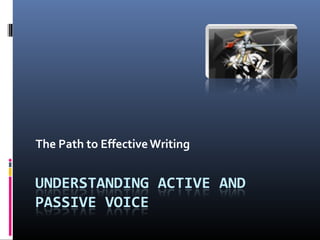
Active and Passive Voice
- 1. The Path to Effective Writing
- 2. Verbs and Voice Voice is the form a verb takes to indicate whether the subject of the verb performs or receives the action. There are two types of voice: active voice and passive voice.
- 3. Active Voice Active Voice – indicates that the subject of the verb is acting Because the subject does or "acts upon" the verb in such sentences, the sentences are said to be in the active voice.
- 4. Active Voice These examples show that the subject is doing the verb's action. The dog jumped onto the boy. The dog (subject) is doing the jumping (verb). Kristy will give a book report to the class. Kristy (subject) is doing the giving (verb). The computer ate my paper. The computer (subject) is doing the eating (verb).
- 5. Passive Voice In a passive voice sentence, the subject and object flip-flop. The subject becomes the passive recipient of the action. Because the subject is being "acted upon" (or is passive), such sentences are said to be in the passive voice.
- 6. Passive Voice These examples show the subject being acted upon by the verb. The boy was jumped on by the dog. Boy (subject) was being jumped on (verb) A book report will be given by Kristy to the class. Report (subject) will be given (verb). My paper was eaten by the computer. Paper (subject) was being eaten (verb).
- 7. Reasons to Use the Active Voice Most writers prefer to use active voice because it is more direct. Compare Active: The waiter dropped the tray of food. Passive: The tray of food was dropped by the waiter.
- 8. Reasons to Use the Active Voice The active voice is less awkward and clearly states relationship between subject and action. Compare Passive: Your request for funding has been denied by the review committee. Active: The review committee denied your request for funding. The active voice sentence pattern propels the reader forward through your writing thus avoiding weak prose.
- 9. When to Use Passive Voice In general, the passive voice is less direct, less forceful, and less concise than the active voice. Use the passive voice in the following situations: Use passive voice when you do not know or do not want to reveal the performer of an action. Use passive voice when you want to emphasize the receiver of an action.
- 10. Examples Awkward Passive: My bicycle was repainted by John. Deliberate Passive: My bicycle was repainted. (The performer is not mentioned and the emphasis is on the bicycle.)
- 11. Form of Passive Voice Verbs The passive voice requires a "double verb" and will always consist of a form of the verb "to be" and the past participle (usually the "en/ed/t" form) of another verb. Example: Active: John baked the bread. Passive: The bread was baked by John. (Was is a form of the verb “be”.)
- 12. Form of Passive Voice Verbs Writers should be familiar with the forms of "to be" , often called linking verbs, so that they can easily identify the passive voice in their work. Review the forms of "to be": am, is, are, was, were, be, being, been
- 13. Form of Passive Voice Verbs Note the forms of "to be" in the examples of the verb "to kick" in various forms of the passive voice: is kicked----------------had been kicked was kicked-------------is going to be kicked is being kicked---------will be kicked has been kicked-------can be kicked was being kicked------should be kicked
- 14. Form of Passive Voice Verbs Often passive voice sentences will contain a "by" phrase indicting who or what performed the action. Passive sentences can be easily transformed into active sentences when the object of the preposition "by" is moved to the subject position in the sentence.
- 15. Form of Passive Voice Verbs Examples: Passive: The cookies were eaten by the children. Active: The children ate the cookies. Passive: The tunnels are dug by the gophers. Active: The gophers dug the tunnels.
- 16. Let’s Practice Directions: Change the sentences below to the active voice. 1. The statue is being visited by hundreds of tourists every year. 2. My books were stolen by someone yesterday. 3. These books had been left in the classroom by a careless student. 4. Coffee is raised in many parts of Hawaii by plantation workers. 5. The house had been broken into by someone while the owners were on vacation.
- 17. Let’s Practice Directions: Change the sentences below to the passive voice. 1. Children cannot open these bottles easily. 2. The government built a road right outside her front door. 3. Mr. Ross broke the antique vase as he walked through the store. 4. When she arrived, the changes amazed her. 5. The construction workers are making street repairs all month long.